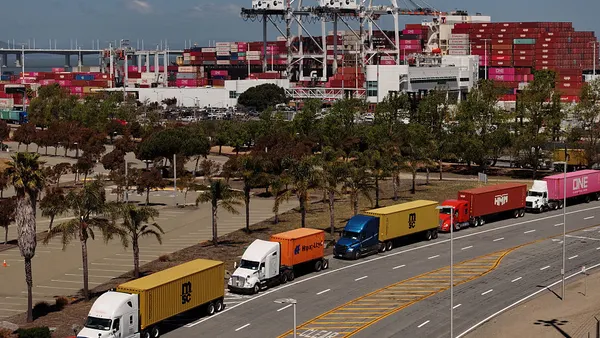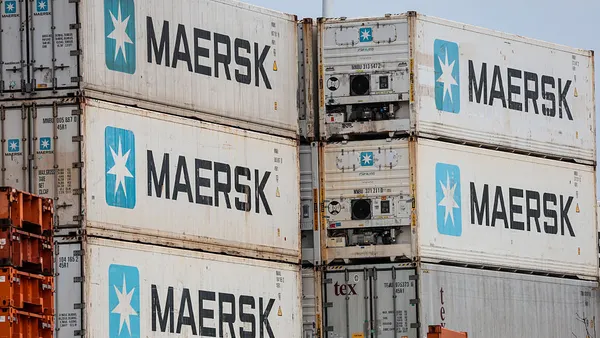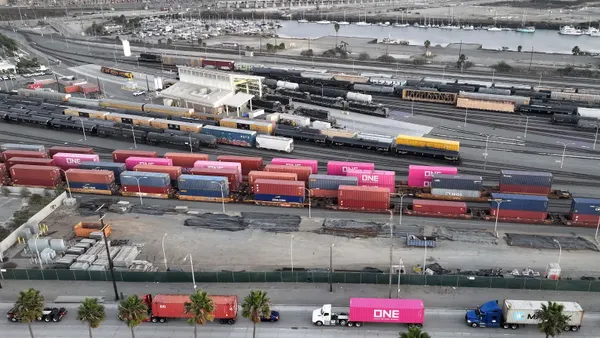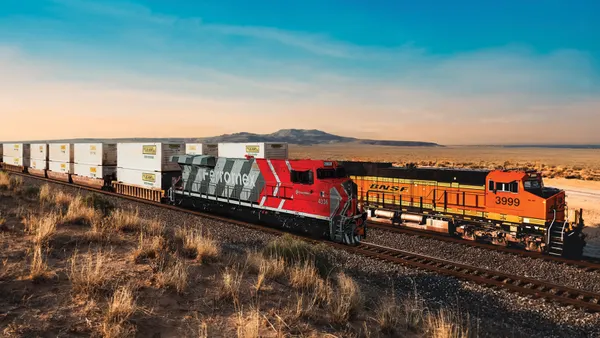The trucking sector is undergoing a capacity tightening, one that could last well into 2021, and a top factor is a shortage of available drivers.
Driver retirements, career changes and the pandemic's effects on driver's licensing bureaus and training schools are contributing to the shortage. The industry could be down by as many as 200,000 drivers by year's end, according to a U.S. Xpress official, all while volumes climb.
Many drivers are hesitant to return to work, likely because of the pandemic, said Dean Croke, principal analyst for DAT, and that contributes to the tightening capacity. The driver hesitancy mixes in with the usual suspects and some new players: surging volumes, not enough physical trucking capacity added back yet, and a national imbalance in freight volumes caused by the pandemic and uneven recovery, Croke said.
The driver shortage is a big piece of the puzzle, said Derek Leathers, Werner CEO. And it explains why the market cannot quickly add capacity, even as signs point to surging demand.
"We clearly have a supply and demand imbalance," Leathers said. "Normally, the market reads that by adding capacity ... It's going to be a long time to add back that capacity."
Drivers caught in a 'clogged' training pipeline
Don Lefeve, president and CEO of the Commercial Vehicle Training Association, saw the signs pointing to forthcoming driver and capacity issues. Training and licensing procedures slowed, Lefeve said, meaning that, even if new recruits were arriving, it would take time to get them into the driver's seat.
"When you start to see the economy turn ... you're going to see a huge capacity crunch," said Lefeve in June. "[The driver shortage] will go from nothing to on steroids."
The issue popped up in the second quarter, even as some fleets laid off drivers during that hectic period. In YRC's Q2 earnings presentation, CFO Jamie Pierson told analysts, "I can tell you with 100% certainty that the capacity crunch is real. We are having difficulty recruiting drivers to keep up with the increase in volume."
"We think it is likely there could be 150,000 to 200,000 drivers that come out of the market within this calendar year."

Eric Peterson
U.S. Xpress CFO
Before the COVID-19 pandemic, the American Trucking Associations first documented the driver shortage in a 2005 report, when it put the number at 20,000. Since then, the problem has grown. In its July 2019 report on driver shortages, ATA Chief Economist Bob Costello put the number at 61,000 for 2018.
The American Transportation Research Institute found the issue to be the No. 1 concern within the industry, releasing its findings in its annual report in October 2019. ATRI officials said, in the longer term, there could be a "potential shortfall of over 100,000 drivers over the next five years." Then came COVID-19.
The driver shortage consistently ranks as a top issue
| 2015 | 2016 | 2017 | 2018 | 2019 | |
|---|---|---|---|---|---|
| 1 | HOS | ELD mandate | Driver shortage | Driver shortage | Driver shortage |
| 2 | Compliance and safety | HOS | ELD mandate | HOS | HOS |
| 3 | Driver shortage | Regulations | HOS | Driver retention | Driver compensation |
| 4 | Driver retention | Truck parking | Truck parking | ELD mandate | Detention/delays |
| 5 | Truck parking | Economy | Driver retention | Truck parking | Truck parking |
Source: The American Transportation Research Institute
Leathers, whose company owns several training schools, said the pandemic has, so far, meant that U.S. license branches have issued 100,000 fewer CDLs, compared to this time in 2019, because they closed or slowed down issuances. And driver throughput, the process in which a student goes from being trained to getting a CDL, is down 40%, Leathers said.

Community college campuses and truck driver schools canceled in-person instruction for a while, then installed social-distancing measures. In 17 states, the backlog to get a commercial learner's permit is 30-90 days, with social distancing and COVID-19 prevention measures causing delays, Lefeve said.
"We can't start on-the-road training without a CLP," said Lefeve — it's the first physical step to getting a CDL. "You are only as good as your weakest link."
Lefeve said recruiting new people for CDL schools is going well, but they are caught in a "clogged" pipeline.
"It's going to be a long time to add back that capacity."

Derek Leathers
Werner CEO
The industry is also dealing with driver retirements. Trucking is older than most industries, according to a 2019 shortage report by ATA. "The median age of over-the-road truck drivers is 46, compared with just 42 for all U.S. workers. Some sectors within the trucking industry have an even higher median age. For example, private fleet drivers have a median age of 57 years old." (The ATA does not track driver retirements by month or year and does not have numerical estimates.)
Eric Peterson, US Xpress CFO, told analysts during his company's Q2 earnings call on July 28 that, with all factors included, such as terminations for drug and alcohol violations, "we think it is likely there could be 150,000 to 200,000 drivers that come out of the market within this calendar year."
The Labor Department's Bureau of Labor Statistics reported the truck transportation sector is down about 82,000 drivers in August, compared to August 2019.
Fleets struggle to recruit as pandemic fatigue sets in
Nearly twice as problematic as the latest BLS data is Costello's forecast for eight years from now: "If current trends hold, the shortage could swell to over 160,000 by 2028."
After retirements, the second-largest reason for needed drivers is industry growth, which will account for 25% of demand for new hires, Costello wrote. Growth and a shortage can be seen in current statistics, mixing like oil and water.
"Tender rejections are at their highest levels since we started tracking in February 2018," said Craig Fuller, CEO of FreightWaves, in a message to Transport Dive. "'Driver 'squeeze' is real. Drivers are not coming back, and finding alternative work in construction, warehousing, and local delivery."

COVID-19 initially softened turnover, and retention shot up, as drivers did not want to make a career jump during a pandemic, according to Max Farrell, CEO of WorkHound, a real-time feedback platform used by transport and distribution companies. Then something changed in the summer.
"In July and August, it was almost like a light switch went on," said Farrell.
Fleets went from record retention in Q2 to struggling to find enough drivers to meet demand, Farrell said.
"There's speculation there is pandemic fatigue" among drivers, he said.
Farrell said competition from other industries, such as construction, is a factor. Since June, 43,000 construction jobs have been added, according to seasonally adjusted data from the BLS.
Fleets are responding to competition from other industries by studying how to enable drivers to spend more time at home, Farrell said. Looking at how long stretches of lanes are operated is one point of examination, Farrell said, and allowing shorter, more regional transport is another.
How to address shrinking ranks
The industry is making some progress in adding workers back. BLS reported the truck transportation sector added 10,000 jobs in August, compared to July. But August numbers were a drop of 5.4% year over year (YoY).
The federal government is working on solutions.
The FMCSA announced on Sept. 4 that it will take a round of public comments on another pitch for a pilot program to allow drivers aged 18 to 20 to operate commercial motor vehicles across state lines. This builds on the agency's 2019 request for comments.
Drivers aged 18 to 20 can operate in 49 states and the District of Columbia now (Hawaii is the exception), but they cannot cross state lines. Proponents say the rule will help ease the driver shortage, but the Teamsters, the Owner-Operator Independent Drivers Association, Advocates for Highway and Auto Safety and others oppose the proposal.
"I would be shocked if there weren't pay increases announced in Q4."

Max Farrell
CEO, WorkHound
Farrell said fleets will likely take that first and most obvious step toward winning back, retaining and recruiting drivers in a few weeks.
"I would be shocked if there weren't pay increases announced in Q4," said Farrell. "[Fleets] are trying to figure out how they can get a competitive advantage in pay."
Farrell said another step fleets can take to retain and attract drivers is to talk about why their fleet is the best to work at and how concerns are addressed.
"We're still in a pandemic. Now is the time to overcommunicate," said Farrell. "Talk about what you're doing to keep the business strong."















